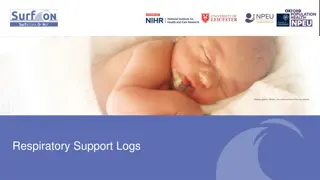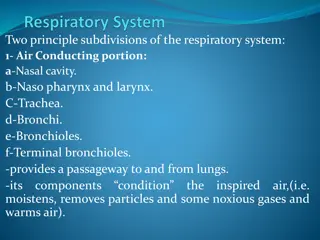Management of Respiratory Infections - Overview and Guidelines
Respiratory infections, including COVID-19, are common among children and young people. This guide covers symptoms, management, outbreak protocols, and when to contact Health Protection Teams. It emphasizes infection prevention, control measures, vaccination programs, and the importance of staying home when unwell. The content also touches on living with COVID-19 and when to isolate after testing positive.
Download Presentation

Please find below an Image/Link to download the presentation.
The content on the website is provided AS IS for your information and personal use only. It may not be sold, licensed, or shared on other websites without obtaining consent from the author.If you encounter any issues during the download, it is possible that the publisher has removed the file from their server.
You are allowed to download the files provided on this website for personal or commercial use, subject to the condition that they are used lawfully. All files are the property of their respective owners.
The content on the website is provided AS IS for your information and personal use only. It may not be sold, licensed, or shared on other websites without obtaining consent from the author.
E N D
Presentation Transcript
MANAGEMENT OF RESPIRATORY INFECTIONS September 2022 Nyari Maliko Health Protection Practitioner Yorkshire & Humber HPT
Overview Management of common respiratory infections including COVID-19 and other respiratory infections Symptoms of Common respiratory infections (e.g., Covid, Influenza & Respiratory Syncytial Virus(RSV) Management of outbreak/incidents & when to contact HPT Information gathering before contacting local HPT Infection Prevention Control (IPC) measures Managing infections and exclusion advice Vaccination programmes Management Of Respiratory Infections 2
INTRODUCTION Management Of Respiratory Infections 3
Background Respiratory infections are common in children and young people, particularly during winter months. Symptoms can be caused by several respiratory infections; e.g. common colds, COVID-19 and RSV. Children and young people with mild symptoms such as a runny nose, sore throat, or slight cough, who are otherwise well, can continue to attend their education setting. Those unwell , or with high temperature should stay at home and avoid contact with other people. They can go back to school, or childcare, and resume normal activities when they are afebrile & well enough to attend. Management Of Respiratory Infections 4
Symptoms of respiratory infections, including COVID- 19 continuous cough high temperature, fever or chills loss of, or change in, your normal sense of taste or smell shortness of breath unexplained tiredness, lack of energy muscle aches or pains that are not due to exercise reduced/loss of appetite headache that is unusual or longer lasting than usual sore throat, stuffy or runny nose diarrhoea, nausea & or vomiting Management Of Respiratory Infections 5
COVID-19 Living with Covid It is not recommended that children and young people are tested for COVID-19 unless directed to by a health professional. If a child or young person has a positive COVID-19 test result they should try to stay at home and avoid contact with other people for 3 days after the day they took the test (5days for adults) After 3 days, if they feel well and do not have a high temperature, the risk of passing the infection on to others is much lower. This is because children and young people tend to be infectious to other people for less time than adults. Children and young people who usually go to school, college or childcare and who live with someone who has a positive COVID-19 test result should continue to attend as normal Although many people will no longer be infectious to others after 5 days, some people may be infectious to other people for up to 10 days from the start of their infection. You should avoid meeting people at higher risk of becoming seriously unwell from COVID-19 Management of respiratory infections 6
Respiratory syncytial virus (RSV) RSV is one of the common viruses that cause coughs and colds in winter. Transmission; Large droplets from contact with an infected person Incubation period ; is short, about 3 to 5 days. When RSV circulates: generally start in October and last for 4 to 5 months, peaking in December High-risk groups; Under 1 year of age and the elderly are at the greatest risk. infants aged less than 6 months frequently develop the most severe disease such as bronchiolitis and pneumonia, which may result in hospitalisation Statistics ; Over 60% of children have been infected by their first birthday, and over 80% by 2 years of age Symptoms; similar to a cold, including rhinitis (runny nose, sneezing or nasal congestion), cough, fever, ear infections and croup Risks; most common cause of bronchiolitis in infants Prevention; respiratory &hand hygiene, (washing with soap and warm water, and cleaning of surfaces) Management of respiratory infections 7
Influenza(Seasonal Flu) Transmission: Droplet spread. Incubation period: 1-4 days with average of 2 days Infectious period: Usually the day before symptoms start, until 5-6 days while symptomatic Common Symptoms: Headache, fever, sore throat, aching muscles and joints, gastrointestinal symptoms in children Exclusion period: If symptoms remain then individual is still infectious. Return when no fever and fully recovered. Prevention : Flu vaccinations now part of the childhood vaccinations in all primary school year groups. Children at risk: Chronic heart, chest or kidney diseases are offered annual vaccines . Pregnant staff: Offered flu jab during pregnancy. Implications for schools: If suspecting an outbreak inform Health Protection Team for advice Management Of Respiratory Infections 8
Seasonal Flu Outbreak Definition An outbreak is defined as: the occurrence of 2 or more cases of influenza-like illness and /or confirmed cases, with a shared exposure such as attending the same school group (such as class group), with onset dates within a single 7-day period and with evidence of transmission within school/nursery Seasonal influenza may transmit rapidly between children of school going age, prompting the occurrence of localised outbreaks within the setting The end of an outbreak is defined as a single 7-day period following symptom onset of the last outbreak case during which there are no new cases of influenza like illness and/or confirmed cases within the same school group Management Of Respiratory Infections 9
Investigation of influenza outbreak Information required by the health protection team to conduct the risk assessment size of the school/nursery/class size of year group (s) affected if illness is limited to specific years (or age groups/rooms for nurseries) day pupils only, boarders or both? any pupils with special educational needs or disability (SEND) or any within the mainstream school main contact person at the school (including their job title and direct contact number) dates of childhood influenza vaccination and coverage rates in the school nature of the symptoms timeline of cases ( ie onset date of the first ,most recent cases according to class/year group ) number of hospitalisations, ICU admissions and deaths associated with the outbreak if known any children in clinical risk groups in the school, if known Management Of Respiratory Infections 10
Management of suspected outbreaks Response Measures Raising awareness among parents and guardians that influenza-like illness has been observed in the school/nursery UKHSA can assist in providing letters which the setting disseminates through their normal route Exclusion advice symptomatic children and teachers should be excluded until they are asymptomatic IPC Measures ; giving clear respiratory & hand hygiene measures within the school/nursery Closure ; UKHSA does not make the decision to close setting only in highly exceptional circumstances Any decision to temporarily close for business continuity reasons such as staff shortages, is a decision for the school/nursery management team and local education authority and should be made clear to parents, guardians and staff that this decision has not been made on public health grounds Management Of Respiratory Infections 11
Respiratory Hygiene And Cough Etiquette Management Of Respiratory Infections 13
Sanitary facilities Good hygiene practices depend on adequate facilities. A hand wash basin with warm running water along with a mild liquid soap, preferably wall mounted with disposable cartridges, should be available. Disposable paper towels next to basins in wall mounted dispensers & nearby foot-operated wastepaper bin. Toilet paper should be available in each cubicle. Management Of Respiratory Infections 15
Keep occupied spaces well ventilated Ventilation allows fresh air into indoor spaces can help remove air that contains virus particles and prevent the spread of COVID-19 and other respiratory infections If there are areas of the setting identified that may have poor ventilation, there are several simple things that can be done to improve ventilation. These include: partially opening windows and doors to let fresh air in opening higher level windows to reduce draughts opening windows for 10 minutes an hour or longer can help increase ventilation where possible this can happen when the room is empty in between lessons, for example Management Of Respiratory Infections 16
Vaccination Programme A table showing when vaccines are offered to children aged 1 to 15 Age Vaccines 1 year Hib/MenC (1st dose) MMR (1st dose) Pneumococcal (PCV) vaccine (2nd dose) MenB (3rd dose) 2 to 10 years Flu vaccine (every year) 3 years and 4 months MMR (2nd dose) 4-in-1 pre-school booster 12 to 13 years HPV vaccine 14 years 3-in-1 teenage booster MenACWY Management Of Respiratory Infections 17
Coronavirus (COVID-19) vaccination Management of Respiratory Infections 18
RESOURCES Health protection in education and childcare settings - GOV.UK (www.gov.uk) People with symptoms of a respiratory infection including COVID-19 - GOV.UK (www.gov.uk) People with Symptoms_easyread__130522_v10.pdf (publishing.service.gov.uk) Chapter 3: public health management of specific infectious diseases - GOV.UK (www.gov.uk) https://www.hse.gov.uk/coronavirus/hand-sanitiser/choosing-hand-sanitiser-surface-disinfectant.htm https://www.who.int/teams/integrated-health-services/infection-prevention-control/hand-hygiene/training-tools Your choices in the NHS - NHS (www.nhs.uk) https://www.gov.uk/guidance/living-safely-with-respiratory-infections-including-covid-19 Management of Respiratory Infections 19























